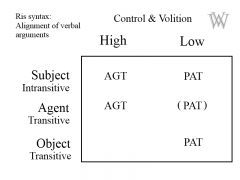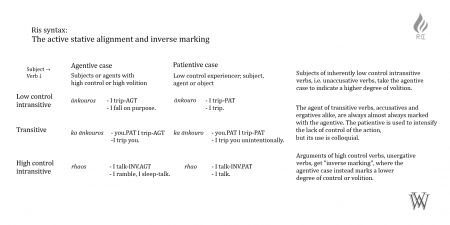User:Waahlis/Sandbox/Ris: Difference between revisions
mNo edit summary |
No edit summary |
||
| Line 14: | Line 14: | ||
|phrase = Ānkouro. | |phrase = Ānkouro. | ||
|IPA = /ˈaːŋkʊrɔ/ | |IPA = /ˈaːŋkʊrɔ/ | ||
|morphemes = ānkour-{{blue|o}} | |morphemes = ānkour-∅-{{blue|o}} | ||
|gloss = to trip.ACT | |gloss = to trip.ACT-IND.PRFV-{{blue|PAT}}.1.SG | ||
|translation = I fell. | |translation = I fell. | ||
}} | }} | ||
{{Gloss | {{Gloss | ||
|phrase = | |phrase = Mīthrani hentai inistin. | ||
|IPA = / | |IPA = /ˈmɪːθranɪ ˈçɛntaj ˈɪnɪstɪn/ | ||
|morphemes = | |morphemes = mīthra-{{blue|ni}} in-ist-{{blue|in}} | ||
|gloss = | |gloss = squirrel_soup.III-{{blue|PAT}}.DC okay.ADJ.PAT exist-ACT-IND.IPFV-3.{{blue|PAT}}.DC | ||
|translation = Okay squirrel soups exist. | |translation = Okay squirrel soups exist. | ||
}} | }} | ||
| Line 31: | Line 31: | ||
|IPA = /ˈtageːrras ˈkeːraks/ | |IPA = /ˈtageːrras ˈkeːraks/ | ||
| morphemes = tagēr-r-as kērax-{{blue|∅}} | | morphemes = tagēr-r-as kērax-{{blue|∅}} | ||
| gloss = | | gloss = hit.ACT-IMP.PRFV-2.SG.AGT bird.I-{{blue|PAT}}.SG | ||
| translation = Hit the bird. | | translation = Hit the bird. | ||
}} | }} | ||
| Line 37: | Line 37: | ||
{{Gloss | {{Gloss | ||
|phrase = Anēr, ouinēstra teskho... | |phrase = Anēr, ouinēstra teskho... | ||
|IPA = / | |IPA = /ˈaneːr wɪˈneːstra ˈtɛskʰɔ/ | ||
|morphemes = anēr-∅ ouinēstra-∅ teskh-{{blue|o}} | |morphemes = anēr-∅ ouinēstra-∅ teskh-∅-{{blue|o}} | ||
|gloss = mother.I-VOC.SG window.II-{{blue|PAT}}.SG | |gloss = mother.I-VOC.SG window.II-{{blue|PAT}}.SG smash.ACT-IND.PRFV-{{blue|PAT}}.1.SG | ||
|translation = Mother, I happened to smash the window... | |translation = Mother, I happened to smash the window... | ||
}} | }} | ||
| Line 49: | Line 49: | ||
|IPA = /maw kaˈteːrɔ ˈktɛrma/ | |IPA = /maw kaˈteːrɔ ˈktɛrma/ | ||
|morphemes = {{red|mau}} katēr-∅-{{red|o}} kterma-{{blue|∅}} | |morphemes = {{red|mau}} katēr-∅-{{red|o}} kterma-{{blue|∅}} | ||
|gloss = 1.{{red|AGT}}.SG | |gloss = 1.{{red|AGT}}.SG writeACT-IND.PRFV-{{red|IN.PAT}}.1.SG letter.III-{{blue|PAT}}.SG | ||
|translation = I am writing a letter. | |translation = I am writing a letter. | ||
}} | }} | ||
| Line 57: | Line 57: | ||
|IPA = /ˈhɛ tɛˈtʰʊːrɪ/ | |IPA = /ˈhɛ tɛˈtʰʊːrɪ/ | ||
|morphemes = {{red|he}} te~thoūr-{{red|is}} | |morphemes = {{red|he}} te~thoūr-{{red|is}} | ||
|gloss = 2.{{red|AGT}}.SG | |gloss = 2.{{red|AGT}}.SG IND.ITR~run.ACT-1.{{red|AGT}}.SG | ||
|translation = He is running around. | |translation = He is running around. | ||
}} | }} | ||
| Line 65: | Line 65: | ||
|IPA = /ˈaːŋkʊros/ | |IPA = /ˈaːŋkʊros/ | ||
| morphemes = ānkour-∅-{{red|os}} | | morphemes = ānkour-∅-{{red|os}} | ||
| gloss = | | gloss = trip.ACT-IND.PRFV-{{red|AGT}}.1.SG | ||
| translation = I purposely trip...! | | translation = I purposely trip...! | ||
}} | }} | ||
| Line 78: | Line 78: | ||
|phrase = Ekrasi mākhina. | |phrase = Ekrasi mākhina. | ||
|IPA = /ˈɛkrasːi maːˈkʰɪna/ | |IPA = /ˈɛkrasːi maːˈkʰɪna/ | ||
|morphemes = ekras-{{blue|i}} mākhina-{{blue|∅}} | |morphemes = ekras-∅-{{blue|i}} mākhina-{{blue|∅}} | ||
|gloss = | |gloss = crash.ACT-IND.PRFV-{{blue|PAT}}.3.SG | ||
|translation = The car crashed. | |translation = The car crashed. | ||
}} | }} | ||
| Line 87: | Line 87: | ||
|IPA = /ˈaneːr psaːˈnɪstɪ/ | |IPA = /ˈaneːr psaːˈnɪstɪ/ | ||
|morphemes = anēr-{{blue|∅}} psān-ist-{{blue|ɪ}} | |morphemes = anēr-{{blue|∅}} psān-ist-{{blue|ɪ}} | ||
|gloss = mother.I-PAT.SG | |gloss = mother.I-PAT.SG cry.ACT-IND-IMPV-{{blue|PAT}}.3.SG | ||
|translation = Mother cries. | |translation = Mother cries. | ||
}} | }} | ||
| Line 94: | Line 94: | ||
|phrase = Ngaos. | |phrase = Ngaos. | ||
|IPA = /ŋgaˈos/ | |IPA = /ŋgaˈos/ | ||
|morphemes = nga-{{red|os}} | |morphemes = nga-∅-{{red|os}} | ||
|gloss = | |gloss = sleep.ACT-IND.PRFV-{{red|AGT}}.1.SG | ||
|translation = I am trying to sleep. | |translation = I am trying to sleep. | ||
}} | }} | ||
| Line 103: | Line 103: | ||
|phrase = He gāmi! | |phrase = He gāmi! | ||
|IPA = /hɛ gaːˈmi/ | |IPA = /hɛ gaːˈmi/ | ||
|morphemes = he gām-{{blue|i}} | |morphemes = he gām-∅-{{blue|i}} | ||
|gloss = 3.PROX.MA.SG to come.ACT-IND.IMPV-{{blue|INV.PAT}}.3.SG | |gloss = 3.PROX.MA.SG to come.ACT-IND.IMPV-{{blue|INV.PAT}}.3.SG | ||
|translation = He's coming! | |translation = He's coming! | ||
| Line 112: | Line 112: | ||
|IPA = /ˈantjʊ r̥ʰaˈɔs/ | |IPA = /ˈantjʊ r̥ʰaˈɔs/ | ||
|morphemes = anti-ou rha-ist-{{red|os}} | |morphemes = anti-ou rha-ist-{{red|os}} | ||
|gloss = night.IV-LOC.DC | |gloss = night.IV-LOC.DC talk.ACT-IND.IMPV-{{red|INV.AGT}}.1.SG | ||
|translation = I sleep-talk in the night. | |translation = I sleep-talk in the night. | ||
}} | }} | ||
| Line 119: | Line 119: | ||
|phrase = Ti rhās? | |phrase = Ti rhās? | ||
|IPA = /tɪ ˈr̥ʰaːs/ | |IPA = /tɪ ˈr̥ʰaːs/ | ||
|morphemes = ti rha-{{red|as}} | |morphemes = ti rha-∅-{{red|as}} | ||
|gloss = what.PAT.SG | |gloss = what.PAT.SG talk.ACT-IND.PRFV-{{red|INV.AGT}}.2.SG | ||
|translation = What are you trying to say? | |translation = What are you trying to say? | ||
}} | }} | ||
| Line 127: | Line 127: | ||
|phrase = Kinizas, kinizas! | |phrase = Kinizas, kinizas! | ||
|IPA = /kɪnɪˈd͡zas kɪnɪˈd͡zas/ | |IPA = /kɪnɪˈd͡zas kɪnɪˈd͡zas/ | ||
|morphemes = kiniz-{{red|as}} | |morphemes = kiniz-∅-{{red|as}} | ||
|gloss = | |gloss = drive.ACT-IND.PRFV-{{red|INV.AGT}}.2.SG | ||
|translation = You're driving, you're driving! (''How is it possible?'') | |translation = You're driving, you're driving! (''How is it possible?'') | ||
}} | }} | ||
Revision as of 09:44, 27 July 2013
Morphosyntactic alignment and the core cases
Ris possess an originally active-stative alignment, which means that the two arguments of transitive verbs, the subject and object, are marked with the agentive case and patientive case respectively. The agent of an intransitive verb, however, can be marked with either. The agentive and patientive cases denote a different degree of control and volition with the arguments. Depending on the intransitive verb, different cases would be used.
It later developed the so-called fluid-S subtype, which infers that any intransitive verb can use both the patientive and agentive cases, wich each grant a different degree of control of the verb.
Patientive case
The patientive, or undergoing case, (pat) is the case used to indicate both the subject of an intransitive verb and the object of a transitive verb, in addition to being used for the citation form of nouns.
The patientive is used on low control agents, and experiencers of actions - neither of which have much influence on the verb. Colloquially, the patientive can be used on agents of transitive verbs to indicate a degree of innocence, lack of control of the event.
- Ānkouro.
/ˈaːŋkʊrɔ/
ānkour-∅-o
to trip.ACT-IND.PRFV-PAT.1.SG
I fell.
- Mīthrani hentai inistin.
/ˈmɪːθranɪ ˈçɛntaj ˈɪnɪstɪn/
mīthra-ni in-ist-in
squirrel_soup.III-PAT.DC okay.ADJ.PAT exist-ACT-IND.IPFV-3.PAT.DC
Okay squirrel soups exist.
- Tagērras kērax.
/ˈtageːrras ˈkeːraks/
tagēr-r-as kērax-∅
hit.ACT-IMP.PRFV-2.SG.AGT bird.I-PAT.SG
Hit the bird.
- Anēr, ouinēstra teskho...
/ˈaneːr wɪˈneːstra ˈtɛskʰɔ/
anēr-∅ ouinēstra-∅ teskh-∅-o
mother.I-VOC.SG window.II-PAT.SG smash.ACT-IND.PRFV-PAT.1.SG
Mother, I happened to smash the window...
Agentive case
The agentative (agt) case is used to mark the subject, or agent, of transitive verbs. The agentive marks high control, volitional agents of verbs.
- Mau katēro kterma.
/maw kaˈteːrɔ ˈktɛrma/
mau katēr-∅-o kterma-∅
1.AGT.SG writeACT-IND.PRFV-IN.PAT.1.SG letter.III-PAT.SG
I am writing a letter.
- He tethoūris.
/ˈhɛ tɛˈtʰʊːrɪ/
he te~thoūr-is
2.AGT.SG IND.ITR~run.ACT-1.AGT.SG
He is running around.
- Ānkouros...!
/ˈaːŋkʊros/
ānkour-∅-os
trip.ACT-IND.PRFV-AGT.1.SG
I purposely trip...!
Unaccusatives, unergatives and inversion of cases
Not all intransitive verbs are marked as described above. This only applies to Ris unaccusative verbs. The Ris unergative verbs instead inverse the marking, using the agentive as a default, low-control marking, and the patientive for high-control subjects.
An unaccusative verb is a verb that has an experiencer as its subject, that is; the syntactic subject is not a semantic agent. When the subject is marked with the agentive, the agency, control and volition is increased, and it in effect becomes unergative. It gives a sense of intent, and trying.
- Ekrasi mākhina.
/ˈɛkrasːi maːˈkʰɪna/
ekras-∅-i mākhina-∅
crash.ACT-IND.PRFV-PAT.3.SG
The car crashed.
- Anēr psānisti.
/ˈaneːr psaːˈnɪstɪ/
anēr-∅ psān-ist-ɪ
mother.I-PAT.SG cry.ACT-IND-IMPV-PAT.3.SG
Mother cries.
- Ngaos.
/ŋgaˈos/
nga-∅-os
sleep.ACT-IND.PRFV-AGT.1.SG
I am trying to sleep.
Unergatives are intransitive verbs and have a semantic agent as their subject. When the subject is marked with the agentive case, the verb almost unaccusative, lowering the volition, control and agency with the syntactic subject. In the gloss, unergatives have the letters inv} before the casees. Thus, an unergative with a subject in the agentive conveys a feeling of involuntary actions, or trying.
- He gāmi!
/hɛ gaːˈmi/
he gām-∅-i
3.PROX.MA.SG to come.ACT-IND.IMPV-INV.PAT.3.SG
He's coming!
- Antiou rhaistos...
/ˈantjʊ r̥ʰaˈɔs/
anti-ou rha-ist-os
night.IV-LOC.DC talk.ACT-IND.IMPV-INV.AGT.1.SG
I sleep-talk in the night.
- Ti rhās?
/tɪ ˈr̥ʰaːs/
ti rha-∅-as
what.PAT.SG talk.ACT-IND.PRFV-INV.AGT.2.SG
What are you trying to say?
- Kinizas, kinizas!
/kɪnɪˈd͡zas kɪnɪˈd͡zas/
kiniz-∅-as
drive.ACT-IND.PRFV-INV.AGT.2.SG
You're driving, you're driving! (How is it possible?)

